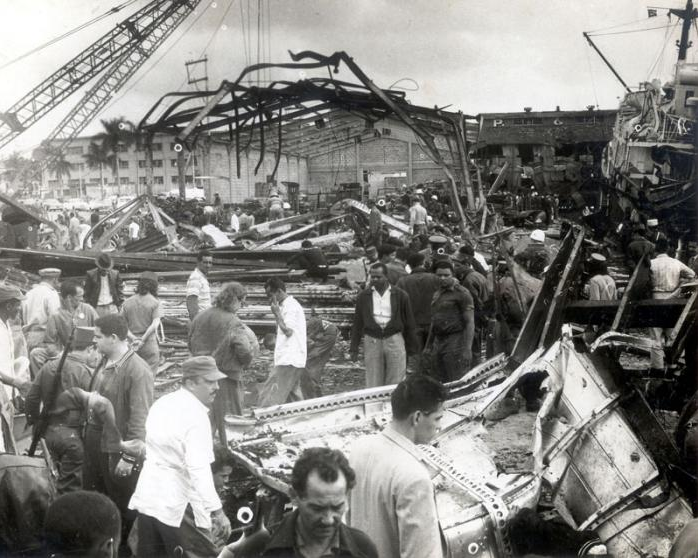
Havana, March 3 (RHC) The French steamship La Coubre arrived in Havana harbor from Antwerp, Belgium, on the morning of March 4, 1960, with 100 tons of grenades and ammunition, in fulfillment of contracts signed with the war industry of that country, mainly for the acquisition of the Light Automatic Rifles (FAL), considered among the best of its time.
Shortly after three o'clock in the afternoon, while the explosives were being unloaded at the then Pan American dock, today La Coubre, the ship exploded, raising a mushroom a kilometer high over the blue sky of Havana. Alarm spread throughout the city and relief efforts began until another explosion, more powerful, caused the greatest number of deaths.
Fidel Castro and other top leaders went to the site of the incident and only minutes apart they did not coincide with the second detonation, evidently programmed to destroy the Revolution, taking into account that is on the front line of events and confrontation in difficult times was an unalterable practice inspired by the example of the Cuban leader.
The vile action killed more than 100 workers and combatants, including six Gallic sailors, and caused hundreds of wounded.
In investigations carried out immediately, Cuban specialists dropped from aircraft boxes of ammunition and grenades that came on the ship, without them exploding, which proved that the sabotage had been organized by the CIA and its accomplices while the ship was in Europe, probably by installing an explosive device in some box that was activated when it was moved.
During the following years, a chain of events proved the role of the U.S. as the ship had as a passenger the American journalist Donald Lee Chapman, who landed before La Coubre arrived at its destination, something somewhat unusual for a ship carrying that kind of cargo and it is still unclear whether he was on board the vessel.
The presumed participation and support of the Dominican dictator Leonidas Trujillo in the event were later revealed, when a secret memo was sent on March 25, 1960, to R.R. Rubottom, Assistant Secretary of State for Inter-American Affairs by the then-American Ambassador to the Dominican Republic, Joseph S. Farland, was declassified, in which he informed that "through a military source it had been confirmed that Porfirio Rubirosa, former army officer, was one of those behind the events of the French ship".
It was also reported that through another source it was learned that the recent trip to Belgium of General Espaillat, former head of Trujillo's Military Intelligence Service, had been for "creating the mechanisms for sabotage".
So far, the U.S. government and its intelligence community have refused to declassify documents on the event.
Fidel concluded the criminal attack as a prelude to a mercenary invasion of the country, and alerted the people to the difficult situation they would face, while denouncing the imperialist plans in the farewell mourning for the victims of the sabotage on March 5.
On the occasion of those dramatic events he raised the slogan that until now accompanies Cuban revolutionaries: [...] we will know how to resist any aggression, we will know how to defeat any aggression, and that once again we would have no other choice than the one with which we began the revolutionary struggle: freedom or death. Only now freedom means something even more: freedom means Homeland. And our dilemma would be Homeland or Death! [...]"

